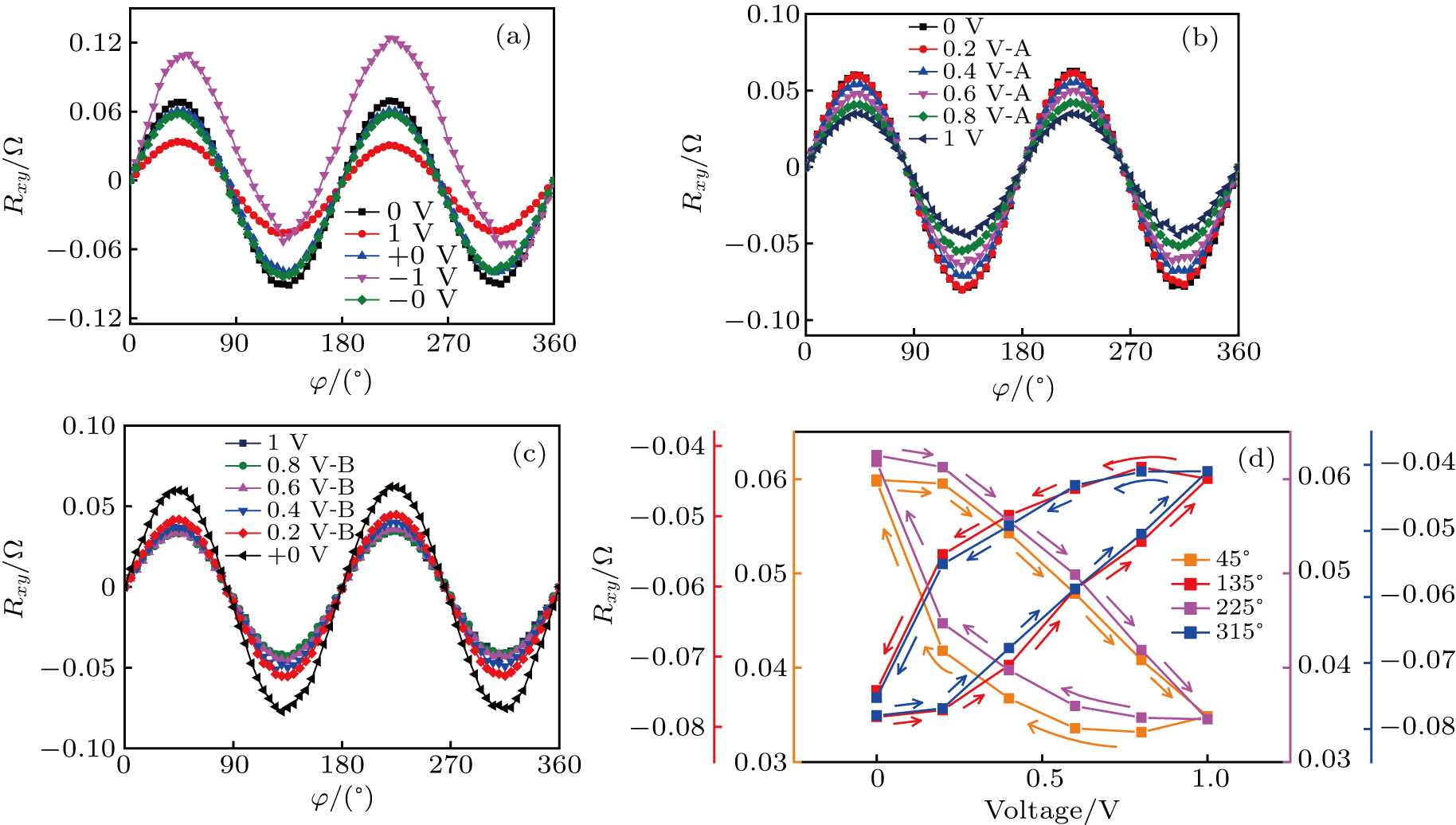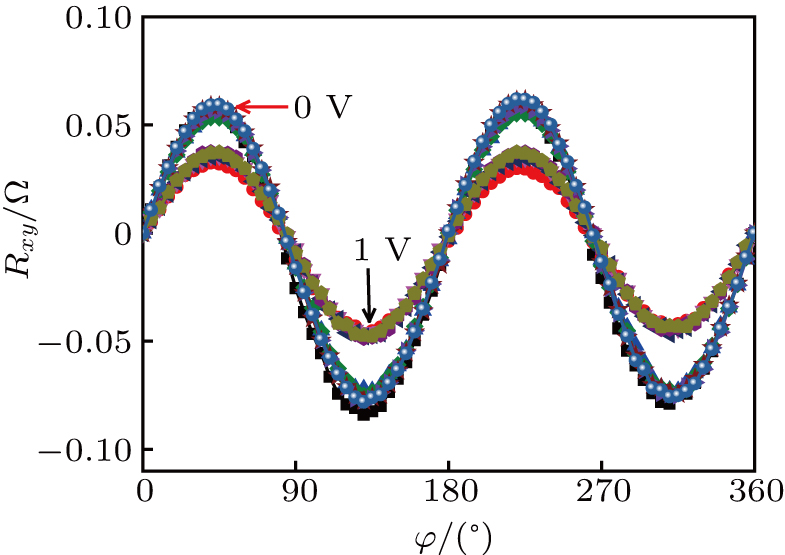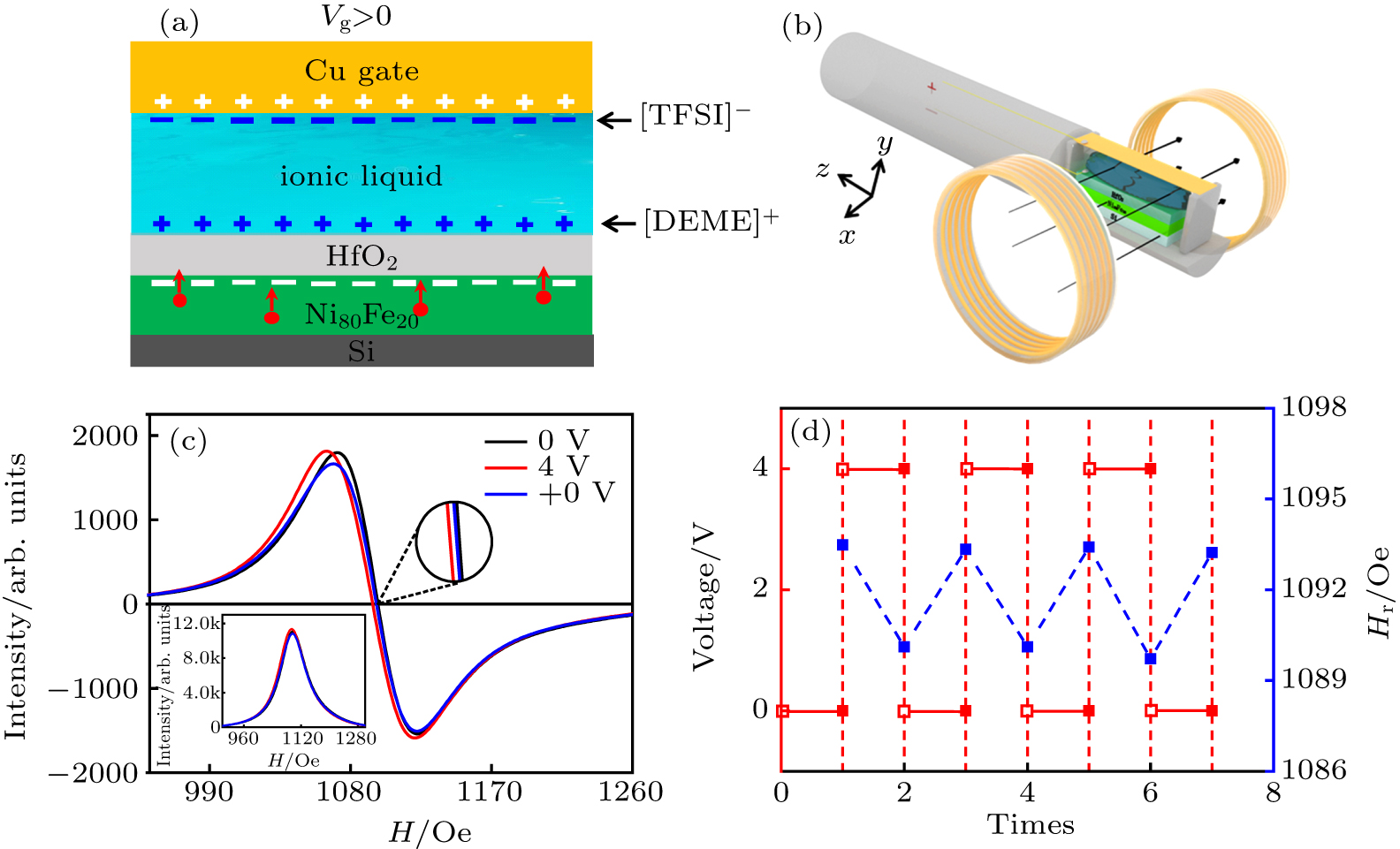† Corresponding author. E-mail:
Project supported by the National Natural Science Foundation of China (Grant Nos. 51671099 and 11974149), the Open Foundation Project of Jiangsu Key Laboratory of Thin Films (Grant No. KJS1745), the Program for Changjiang Scholars and Innovative Research Team in University, China (Grant No. IRT-16R35), and the Fundamental Research Funds for the Central Universities, China.
We report a tunable transverse magnetoresistance of the planar Hall effect (PHE), up to 48% in the Ni80Fe20/HfO2 heterostructures. This control is achieved by applying a gate voltage with an ionic liquid technique at ultra-low voltage, which exhibits a gate-dependent PHE. Moreover, in the range of 0-V to 1-V gate voltage, transverse magnetoresistance of PHE can be continuously regulated. Ferromagnetic resonance (FMR) also demonstrates the shift of the resonance field at low gate voltage. This provides a new method for the design of the electric field continuous control spintronics device with ultra-low energy consumption.
The planar Hall effect (PHE) in ferromagnetic materials, meaning the appearance of an in-plane transverse voltage when the co-planar electric current and magnetic fields are not perfectly aligned to each other, can be considered as a promising candidate for applying in metallic magnetic devices such as magnetic sensors and magnetic random access memory,[1–4] which is resulted from the s–d mixing generated by spin–orbit coupling.[5,6] NiFe alloy with low-cost and availability is one of the common materials for PHE sensors,[1,2] which is based on the planar Hall magnetoresistance, and NiFe alloy has various magnetic properties with the change of Ni content, therefore it has high research value.[7] It is well known that the planar Hall magnetoresistance can be effectively tailored by changing the magnitude of an applied magnetic field, the angle of applied electric current and magnetic field, and the width of Hall bar. However, from a device application perspective, tuning should be reversible and continuous as far as possible. As metallic magnetic devices develop rapidly, the voltage-controlling magnetoelectric coupling in ferromagnetic/ferroelectric heterostructure can not only continuously mediate magnetic properties but also realize the non-volatile behavior of that. For example, Laukhin et al.[8] regulate the exchange bias of the FeNi/YMnO3 heterostructures by an electric field at very low temperatures, which achieved a one-way magnetization switch. Liu et al.[9] controlled the AMR of the Ni80Co20/PZN-PT film and the GMR of the FeMn/Ni80Fe20/Cu/Co/PZN-PT film by an electric field. Nevertheless, the piezo strain-mediated magnetoelectric coupling causes large energy consumption due to high ferroelectric gating voltage.[10–12] Recently, the ionic liquid gating with an electric double layer (EDL) has been widely used for voltage-driven material properties modification, which greatly reduces energy consumption. For instance, Nakano et al.[13] reached a VO2 first-order metal–insulator transition using an ionic liquid at a gate voltage of around 1 V. Zhao et al.[14] controlled the spin reorientation transition of the Pt/(Co/Pt)2/Ta multilayer film by ionic liquid, which accomplished the magnetic moment from the out-of-plane to the in-plane. At the same time, the magnetoresistance is easily tuned by the ionic liquid N, N-diethyl-N-(2-methoxyethyl)-N-methylammonium bis (trifluoromethylsulphonyl) imide (DEME-TFSI).[15–17] Therefore, in this work, the ionic liquid gating-controlling PHE is investigated in Ni80Fe20/HfO2 at room temperature. When the gate voltage is 1 V, the change rate of the transversal reluctance Rxy is as high as 48%, and continuous, reversible and repeated tuning is achieved in the voltage range of 0 V–1 V. At a gate voltage of 4 V, the resonance field Hr drifts by 4 Oe (1 Oe = 79.5775 A⋅m−1), further indicating that the electric field can result in the magnetic change of the Ni80Fe20 film. This provides an important idea for designing continuously adjustable spintronic devices.
Ni80Fe20 with 10-nm thickness was deposited on Si substrate by magnetron sputtering and then was covered by a cap layer HfO2 (7 nm). The measurement of PHE was completed by a self-built transport test platform within an external magnetic field of 1000 Oe. The electric field-controlled PHE device is shown in Fig.
The measurement result of PHE is shown in Fig.
PHE comes from the ferromagnetic layer Ni80Fe20 in the heterostructures, but HfO2 also plays a pivotal role. HfO2 can separate ionic liquid and Ni80Fe20 thin film, preventing direct chemical reactions between them. To achieve a large degree of regulation at a low voltage, it is necessary to increase the carrier density by other methods. The carrier density n is positively correlated with the capacitance C of the dielectric layer, that is, n ∼ CVg/e,[21] where Vg is the gate voltage and e is the electron charge. When Vg is constant, the carrier concentration is increased only by increasing the capacitance C. However, C = κ ε0/d,[21] where κ is the permittivity of the dielectric, ε0 is the vacuum permittivity, and d is the thickness of the dielectric layer. Therefore, increasing the permittivity of the dielectric layer can give rise to capacitance C, so that the carrier density is enhanced. However, HfO2 has a high permittivity κ,[22–24] which can act as a role in increasing the carrier density. When a positive Vg is applied to the ionic liquid using the voltage source Keithley 2410, the cations and anions in the ionic liquid undergo directional movement. The cation [DEME]+ moving toward the negative electrode attracted electrons and O2– to move toward the top surface of the film, forming an EDL at the interface between the ionic liquid and the thin film. As shown in Fig.
Figure
In order to confirm further that the electric field can not only continuously regulate the PHE but also can achieve repeated regulation at the pulse gate voltage, the Ni80Fe20 film was repeatedly tested for PHE curves at gate voltages of 0 V and 1 V. When the Vg was increased or reduced, the waiting time to restart the test became different. After increasing the gate voltage from 0 V to 1 V, a stable electric field will be formed at the interface between ionic liquid and thin film after at least 5 min. After the gate voltage was reduced from 1 V to + 0 V, it took at least 30 minutes to restart the test. As mentioned above, the PHE regulation of Ni80Fe20 thin films by the electric field was non-volatile. The test results are shown in Fig.
 | Fig. 4. (a)–(d) The control diagram of the transverse magnetic resistance Rxy at the extreme point when the 1-V gate voltage was repeatedly applied and removed. |
Generally, the ionic liquid gate tuning magnetic properties is attributed to EDL. However, due to the screening effect, the thickness of the electric field-regulated magnetic film was limited. Especially at the gate voltage of 1 V, the Rxy of the 10-nm thick Ni80Fe20 film changes by 48% when the angle between jx and M is 225°. Therefore, we speculate that in addition to EDL, there may be other mechanisms causing transverse magnetoresistance change. It had been reported that when a magnetic film was covered with oxide as an electrolyte gate, an inevitable oxidation process would exist in the magnetic layer.[28,29] Therefore, it is possible that the Ni80Fe20/HfO2 heterostructures also have an O2– migration process under the action of an electric field. When the positive Vg was applied, [TFSI]− accumulated on the top surface of HfO2 would pump out O2– in the Ni80Fe20 thin film. As shown in Fig.
The results of the electrical transport test have demonstrated that the electric field can regulate the PHE of the Ni80Fe20 thin film. In addition, the FMR in situ electric field control test results also prove that the electric field can regulate the magnetic properties of the Ni80Fe20 thin film. Transfer the test device shown in Fig.
In conclusion, the regulation of PHE of 10-nm thick Ni80Fe20 thin films has been achieved through the ionic liquid gate at ultra-low gate voltage, and this manipulation can be continuous within the 0-V to 1-V gate voltage. In particular, when the angle between jx and M is 225°, the rate of change of Rxy reaches 48%. Furthermore, the results of the FMR test also illustrate that the ionic liquid gate can manipulate the magnetic properties of the Ni80Fe20 thin film. This provides a new idea for the design of spintronic devices with continuous electric field control under low energy consumption.
| [1] | |
| [2] | |
| [3] | |
| [4] | |
| [5] | |
| [6] | |
| [7] | |
| [8] | |
| [9] | |
| [10] | |
| [11] | |
| [12] | |
| [13] | |
| [14] | |
| [15] | |
| [16] | |
| [17] | |
| [18] | |
| [19] | |
| [20] | |
| [21] | |
| [22] | |
| [23] | |
| [24] | |
| [25] | |
| [26] | |
| [27] | |
| [28] | |
| [29] | |
| [30] |





